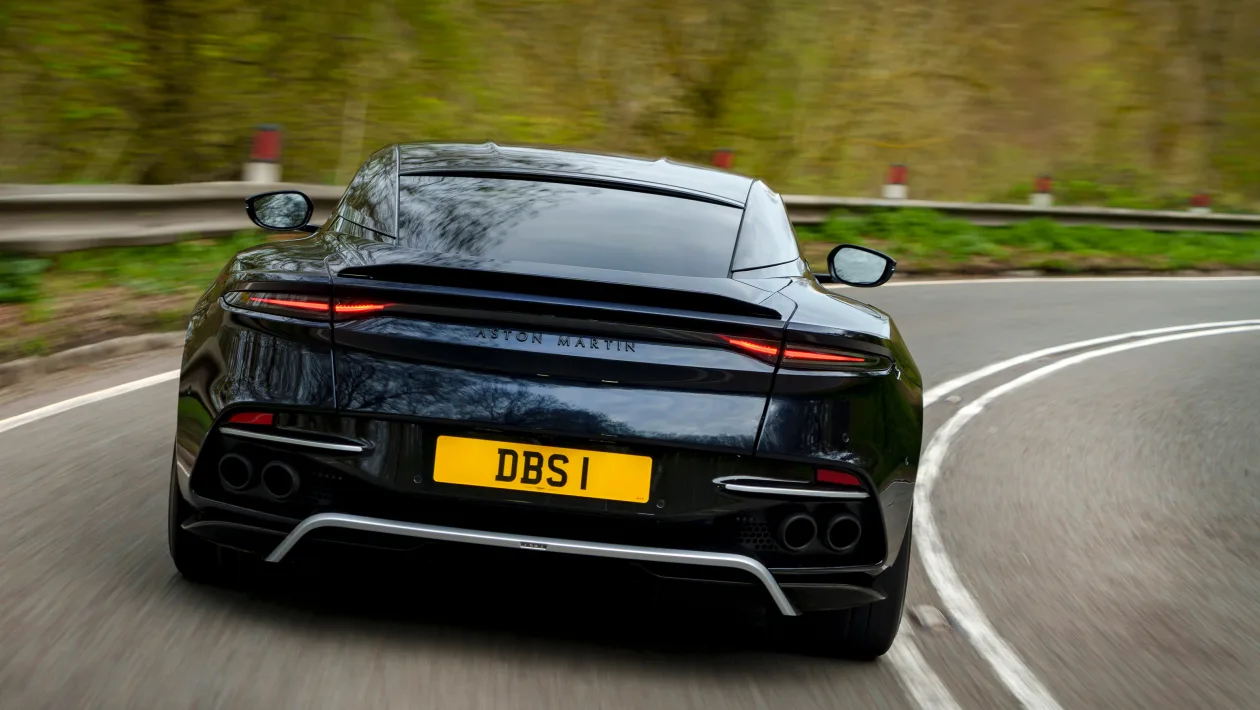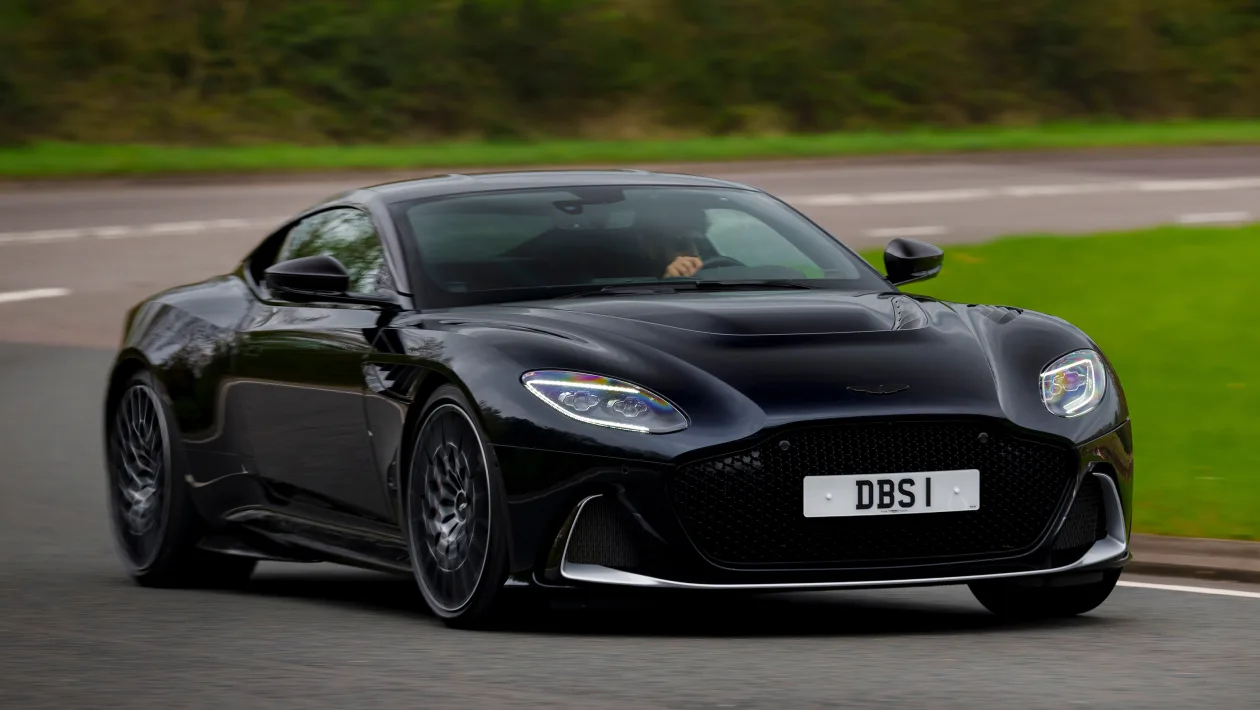The last hoorah for Aston Martin’s V12 flagship is the best yet, matching performance with a clear dynamic polish.
It’s the end of the line for the DBS, so it’s no surprise that Aston Martin has pulled out all the stops for the final DBS 770 Ultimate, perhaps quite literally in the case of its 5.2-litre, twin-turbo V12, which sees power raised from 725 to 770ps. That’s up from 533kW to 566kW, which doesn’t have quite the same ring to it but, ye gods, in whatever measurement of power you choose that’s a spectacular amount of power in a rear-drive GT car. Ask anyone who’s driven the 533kW DBS what it needs and I’d bet good money the least likely answer is ‘more power’, but here we are. The 770 Ultimate takes the accolade of most powerful series production Aston Martin of all time, pipping even the limited run One-77 and its 7.3-litre, naturally aspirated V12 along the way.
All 499 examples – 300 coupes and 199 Volantes – have already been snapped up. I would guess some of those customers are familiar with the current DBS and have looked beyond the power uplift and the tinkering around the edges – and there’s a lot of body and trim tinkering – and towards the meaningful work on the chassis to make the DBS an even more engaging drive.
There does appear to be a concerted effort to increase the feel and connection, particularly in regard to how the DBS steers, with a solidly mounted steering column and a beefed up front subframe. There’s a stiffer rear undertray too, resulting in 25 percent increase in front end lateral stiffness and marginal increases in overall structural stiffness. Building on this, Aston has developed a unique tune for the Skyhook adaptive dampers that is said to enhance composure without compromising the ride.
In the presence of the 770 Ultimate, the first things that strike you are the distinctive and huge-looking new wheels. They’re inspired by the design for the one-off Victor and are shod with the same sized tyres as the standard DBS – 265/35 R21 front and 305/30 R21 rear Pirelli P Zeros. Second is the scale of the car they’re attached to; from the rear, the DBS is simply mahoosive.
The scales agree. This is an 1845kg car even when fitted with all the lightest options. The Ultimate’s vast clamshell bonnet with its unique horseshoe vent is carbonfibre, as is the boot, and a carbon roof is available to match, plus a carbon front splitter, side vents and a new sill extension that starts ahead of the rear wheel and continues after, linking up with the revised rear diffuser.
Inside there’s lots more carbon, notably forming the smooth, sculpted shells of the front seats but also integral to the door casings and centre console. The HMI is recognisably past-gen Mercedes (the last new model in which Aston will use it) but sitting above is Aston’s line of buttons for the auto box – individual P-R-N-D buttons – a layout that is neither ergonomic nor intuitive. However, when you press that larger start/stop button that divides them, the earth rocks a little.
The V12 sounds classy and angry, raw and sophisticated all at once, the hollow bellow from its four tailpipes perfect for attracting attention. It’s hooked up to a conventional eight-speed ZF automatic transmission so initial progress is smooth and effortless. After the start-up flare and accompanying low-speed growl, the engine note melts away to a discreet tone in the lower reaches of the rev range. Pretty quickly you recognise the casual strength of the V12. There’s 5.2 litres before the turbos spool up, so the DBS starts moving as soon as you squeeze the throttle, but when the turbos chip in, which they do from ludicrously low revs with hardly any throttle opening, the DBS lunges forward. It does this from 2000rpm in any gear, and the deeper you’ve pressed the throttle, the deeper the V12 and its turbos will dig. It’s mighty and slightly terrifying performance, eye-widening, jaw-slackening grunt that makes you suddenly more interested in the ability of the rest of the car and your connection with it. Particularly in the wet.
Happily, it’s all good news. Firstly, the ride is firm but fair, taking the edge off all manner of tricky Tarmac, while pitch and roll are well managed, giving the Ultimate a feeling of solid composure. Early DBSs felt soft at the rear, perhaps to aid traction, whereas the Ultimate feels all of a piece yet still finds remarkable traction. The steering is rather good too, precise and slack free, the nose obedient. The efforts are perhaps a fraction high but accurately convey the mass of the car.
You feel connected to the DBS and the traction and stability control system does a truly remarkable job of keeping the rear tyres from slipping without drawing attention to itself with abrupt interjections or a yawning dead throttle pedal. Make no mistake, though, the DBS is no B-road scratcher that you hustle into turns, downshifting for the optimum gear on the exit. It’s too big and too heavy for that. And besides, that twin-turbo V12 has such a broad spread of torque that you can be one or two gears higher and still get phenomenal acceleration away from corners. So relax into the accuracy of the steering and the poise of the chassis (Sport damping is ideal), deploy the V12’s urge judiciously and you’ll still cover the ground at astonishing pace.
Turn off ESP and you quickly appreciate what a brilliant and vital job it does managing the torque. Curiously, the warning light seems busier in the dry, probably because you’re using more throttle sooner. Very occasionally you feel the rear axle squirm as full torque hits but mostly the DBS feels composed as it surges between corners with acceleration that borders on uncomfortable. You’re more aware how much mass is in motion, sensing the inertia mid-corner and occasionally hearing the nose scuff in compressions, yet the standard carbon ceramic brakes feel tireless.
It’s a mighty thing, the DBS 770 Ultimate. It’s the chassis changes that enhance the experience more than the uplift in power, especially as they allow you to use more power with confidence. As we’ve said before, the DBS has no natural rivals, straddling the gap between super GTs like the Bentley Continental and supercars like the Ferrari 812 with a unique blend of style, practicality and stupendous performance. And the Ultimate is the best ever.









